It’s the time of year for saving money!
This review considers original pressings vs. reissues, Mono vs. Stereo … and Rock ‘n Roll vs. The Blues.
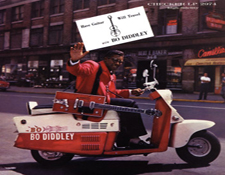 It’s been real real interesting exploring reissues of two seminal albums from the early 1960s which had a great influence on many artists to come into mainstream popularity, particularly those who ascended to international fame amidst the British blues and psychedelic rock movements just a handful of years later.
It’s been real real interesting exploring reissues of two seminal albums from the early 1960s which had a great influence on many artists to come into mainstream popularity, particularly those who ascended to international fame amidst the British blues and psychedelic rock movements just a handful of years later.
That these albums sound so different — yet were issued by essentially the same recording companies — makes them all the more interesting. That the reissues were created by two different and respected specialty entities makes reviewing these together all the more challenging. That both reissues feature music that is sourced from or manufactured by Universal Music makes reviewing these together all the more curious.
That I don’t own original pressings of either makes reviewing these albums all the more difficult to be objective.
Howlin’ Wolf’s third album, sometimes known as The Rockin’ Chair album due to its cover art, is pretty much the template for music created several years later by The Rolling Stones, Jimi Hendrix, The Doors, Cream, The Grateful Dead and so many others from the mid-60s music explosion. This is a collection of six singles which had been released by Chess Records between 1960 and 1962. It really plays almost like a Greatest Hits … I mean… just look at the song titles on this one 30-minute, 12-song record alone: “Little Red Rooster,” “Wang Dang Doodle,” “Spoonful” and “Back Door Man.”
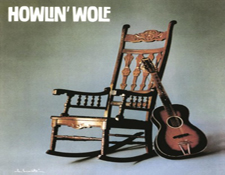 On “Going Down Slow ” we hear the probable birthplace (or one of the birthplaces) of the immortal words which Frank Zappa bestowed upon his character Nanook from his 1973 quazi-hit “Don’t Eat The Yellow Snow” : “Great Googly Moogly!”
On “Going Down Slow ” we hear the probable birthplace (or one of the birthplaces) of the immortal words which Frank Zappa bestowed upon his character Nanook from his 1973 quazi-hit “Don’t Eat The Yellow Snow” : “Great Googly Moogly!”
Hey Kids! Its time to play “Spot The Influence!!”
Bo Diddley’s third album, Have Guitar Will Travel, is also a gem of influence-making with tunes like “She’s Alright,” “Cops & Robbers” and “I Need You Baby” (which many of you will know as “Mona”). Pretty much all of these songs bounce along to that incessant and hypnotic Bo Diddley beat.
You know… Its the one that goes: Bomp! // Bomp-Bomp! // Bomp!-BOMP!
Its essentially the same beat Buddy Holley used on his classic “Not Fade Away.”
All that said, I’m a gonna tell you how its gonna be with this review: these are darn hard records to compare.
Darn hard…
Bo Diddley’s album is in Mono on the Checker Records label, recorded in Chicago in 1960. The reissue from Sundazed Records — in this case manufactured by Universal Music, which owns the label brand and its roster these days — sounds real good. Perhaps a tad brighter than I expected, but the thick, perfectly centered 180-gram vinyl sounds solid when you follow the directions on the hype sticker outside the cover and “Crank It Up!”
“Great Googly Moogly!”
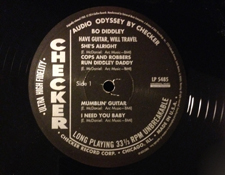 Gotta say, this Sundazed Bo Diddley album sounds especially fine when played via my Mono Denon DL-102 cartridge. Now, I know that there are some of you out there who will argue that since this is a new pressing — and new mastering — it shouldn’t matter that much in terms of playback whether you use a Mono or Stereo cartridge. Certainly, if I was playing an original 1960 pressing that was “deep groove” and all that, one might expect an audible difference.
Gotta say, this Sundazed Bo Diddley album sounds especially fine when played via my Mono Denon DL-102 cartridge. Now, I know that there are some of you out there who will argue that since this is a new pressing — and new mastering — it shouldn’t matter that much in terms of playback whether you use a Mono or Stereo cartridge. Certainly, if I was playing an original 1960 pressing that was “deep groove” and all that, one might expect an audible difference.
I suspect that the subtle variation in the sound that I am hearing comes from the size and shape of the stylus on the Denon, which rides more in the center of the groove vs. the finer tip of the Sumiko Pearl stereo cartridge (which I swap out for stereo playback on this particular turntable). Ultimately, the Mono cartridge makes the recording sound tighter, with less odd flavors on the high end (was that some phasing oddity I heard periodically or an anomaly of digital mastering?). Overall everything seemed to sound a bit less harsh played back via a Mono cartridge.
Your experience may vary…
We do have to consider that this Bo Diddley record — an early rock ‘n roll, rhythm ‘n blues record — is a very different styled recording aimed at a far different audience than Howlin’ Wolf’s raw electric blues recordings. Bo’s record was designed for airplay on rock ‘n roll stations — with predominantly white teenage audiences — so there is more reverb overall to the sound and perhaps compression to get that brighter sound that would pop on a 3-inch portable radio speaker or on the jukebox at the local Malt shop.
The Howlin’ Wolf album is a much more in your face recording and the music was clearly not aimed at the teenage malt-shop Wonderbread-generation audiences. It is in stereo. The sound is warmer and fatter, with a more distinct sense of headroom and dynamics. I have no idea if these records were made in the same studio — Chess and Checker Records were owned by the same team of brothers — but I do know that the producers were different so that alone could account for the difference in sound.
]]>Now, the big question I have for you, Dear Readers, to ponder is simply this:
How much of this different sound is related to
(a) the original recording?
(b) the tape source used?
(c) the mastering done for the final recording as it was prepared for playback on radio (ie. compression, reverb, EQ)?
(d) the mastering done for the LP manufacturing process (wider grooves, additional EQ, etc.)?
(e) other…
I don’t have the answers! But you can see that there really are a lot of different variables to consider in deciding whether you like or dislike a particular recording.
“Great Googly Moogly!”
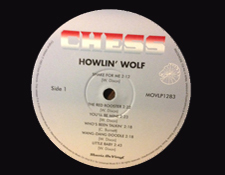 All I can do is to guess with my ears. And in this instance if I had to choose between the two reissues I would go for the Howlin’ Wolf package hands down. It sounds better overall.
All I can do is to guess with my ears. And in this instance if I had to choose between the two reissues I would go for the Howlin’ Wolf package hands down. It sounds better overall.
That the songs are iconic and wonderfully diverse also helps too.
The Bo Diddley album sounds good but even with the Mono cartridge there is something sort of boxy about the recording which I can’t quite put my pulse on. Perhaps it was sourced from a digital master — the cover hype sticker just says it is “sourced from the original Checker masters” but it doesn’t say whether it was made right from the tape to the disc. Or perhaps it is just the difference in recording approach pursued by the producers and their engineer.
The Howlin’ Wolf recording came from a high resolution digital source so clearly there is some kudos to be bestowed upon the producers at Music On Vinyl for making this one sound real fine. Also, its important to note these little details in the fine print at the bottom of the Howlin’ Wolf release : “Manufactured & distributed by Music on Vinyl B.V. for Universal Music B.V.”
So, at its root here we’re loosely comparing releases that were manufactured in Europe (Howlin’ Wolf) vs. the US. and respective approaches to mastering and other quality controls.
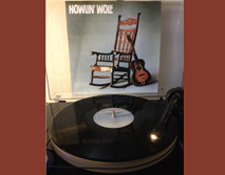 Until I find an original pressing, I won’t really know for sure how these really stack up. But I can’t see how you could go wrong with the Howlin Wolf reissue in particular, especially since originals are super hard to find. Even then, the likelihood is that any original pressing you might find won’t be in this sort of minty pristine condition (unless you want to spend hundreds of dollars via eBay or Discogs).
Until I find an original pressing, I won’t really know for sure how these really stack up. But I can’t see how you could go wrong with the Howlin Wolf reissue in particular, especially since originals are super hard to find. Even then, the likelihood is that any original pressing you might find won’t be in this sort of minty pristine condition (unless you want to spend hundreds of dollars via eBay or Discogs).
Next time you see this in the racks of your favorite store, I suggest you just shout out a resounding“Great Googly Moogly” and grab one of these fine new reissues before they go out of print again. I don’t think you’ll be disappointed.






